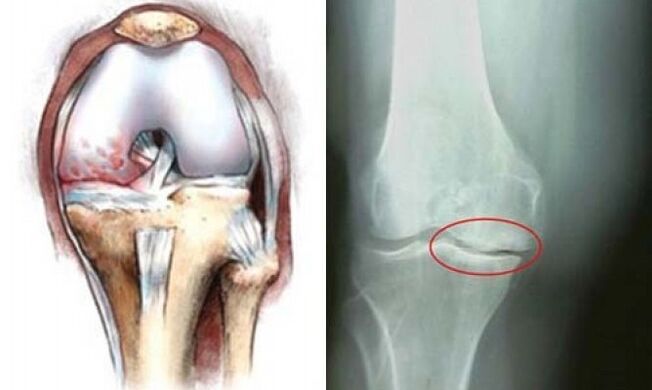Osteoarthritis of the knee joint is very common in the elderly, especially in women. It is also diagnosed in young people. This disease significantly reduces the quality of life and, if not treated properly, can lead to disability.
How to recognize osteoarthritis? What are the causes of this disease? How to cure it?
signals
Osteoarthritis is an injury to the hyaline cartilage of the joint. This cartilage is gradually destroyed. First, its structure, density changes, then it gets thinner. In severe cases, cartilage may be completely absent.
There is always a very strong load on the knee joint, as it is one of the major structural elements of the lower limb. Therefore, signs of osteoarthritis of the knee joint are noticeable even with minor damage to the joint.
In knee osteoarthritis, symptoms are associated with pain and gradual loss of knee function.
There are three stages in the development of the disease. Each of them has characteristic symptoms and requires proper treatment.
First step
The first stage in different people may have different duration. In some, the joint changes progress rapidly, and after a few months, the disease moves to the next stage. In others, dystrophy of the cartilage tissue structure occurs slowly, years pass before new symptoms appear.
Signs of the first stage of osteoarthritis of the knee:
- Intermittent pain in one or both knees. It usually occurs in the morning, when trying to take your first steps, during a long stand, or when going up or down stairs. The reason for the occurrence of particularly pronounced pain is going down stairs. There is no pain at rest.
- There are frequent complaints of a slight feeling of stiffness with intense movements in the joint area. But changes in range of motion are not observed.
- There may be a slight deformity due to fluid in the joint cavity, but the bone is not changed.
All these symptoms indicate the need to see a doctor. If you start treatment at this stage, there is a chance not only to stop the process, but also to start healing processes in some parts of the cartilage.
second stage
If you don't seek medical help, the disease moves on to the next, second stage. At the same time, old symptoms are aggravated and additional complaints appear.
Signs that indicate osteoarthritis has progressed to the second stage:
- The pain intensifies. Occurs with every movement of the foot. With prolonged walks, lifting heavy objects, discomfort is especially pronounced. At rest, the pain gradually subsides.
- When moving, there is pain and a crisis in the affected joint.
- The range of possible movement begins to decrease, which can cause discomfort. When a person tries to bend his leg at the knee all the way, he fails or the bend causes a sharp pain.
- On examination, the doctor notes small changes in the shape of the joint. If an x-ray is taken, it will be seen that the joint space is very narrow and growths form on the bony edges.
- A large amount of fluid can accumulate in the joint cavity. This can be detected during diagnostic procedures and during routine examination.
Most of the time, patients go to the doctor at this stage. In this situation, it is very difficult to achieve a significant recovery, but some positive changes are possible.
third stage

The third stage occurs with severe cartilage destruction and is the most serious. Complaints and test results of a patient with third stage osteoarthritis:
- Severe and almost constant pain in the affected joint. When trying to move, it intensifies. At rest, even in the supine position, the pain does not go away, so there are problems with sleep.
- Movement in the joint is severely limited.
- Often, the knee "freezes" in a slightly bent state. This affects the shape of the patient's leg and gait.
- On examination, marked deformity of the joint and bones is noticeable.
- The x-ray image shows the absence of cartilage in many areas of the joint surface, bone sclerosis. The joint space is sharply narrowed, a large number of osteophytes are found.
The management of these patients is particularly difficult. You may even need surgery.
The reasons
The causes of osteoarthritis of the knee joint are very diverse. Very rarely, a person who has been diagnosed with this disease has only one factor that caused the pathological process. In most cases, changes in cartilage are due to several reasons. The more risk factors, the more intense the destruction and loss of functionality.
Most often, arthritis is brought on by such body characteristics and circumstances:
- age-related changes in the structure of the musculoskeletal system;
- knee injuries, as well as operations where damage to the joint may occur;
- too much load on the lower limbs;
- congenital anomalies of the musculoskeletal system or metabolic processes;
- inflammatory processes of various etiologies in the knee region.
Let's take a look at these groups of causes.
age changes

Most often, osteoarthritis of the knee develops after age 40. This is due to the fact that at this age and at more advanced ages, the structure of bone and cartilage tissue becomes more fragile, their resistance to stress decreases. Therefore, even a long walk can be difficult for the joints of the lower extremities to tolerate.
Changes in the musculoskeletal system in women during menopause are especially pronounced.
During this period, the level of estrogen, which previously protected the bones from calcium loss, gradually decreases, making them more vulnerable.
injuries and operations
In young people, osteoarthritis can occur due to trauma. It could be a broken leg, a dislocated knee, a torn ligament, or a serious injury. The longer the time from the moment of injury to the correct care, the greater the risk of complications and the occurrence of arthrosis in the near future. So even with minor knee injuries, you need to go to the hospital.
There is also a high risk of developing osteoarthritis after surgical interventions in the knee region. Especially dangerous is the removal of the menisci. After such an operation, arthrosis occurs in approximately 80% of patients.
Traumatic osteoarthritis usually develops quickly. Therefore, in these cases, surgical intervention may be necessary.
Overload
Excessive stress on the knees is seen in athletes who are professionally involved in sports related to running, jumping, weightlifting. The older a person becomes, the more carefully he or she must select physical activity options in training. Particularly dangerous for the knees are squats, sudden movements and running on paved paths.
Too much stress on the leg joints is typical of people suffering from obesity. So the weight itself creates a lot of pressure on the cartilage and bones, which leads to their rapid wear and tear.
Congenital pathologies

In case there are pathologies in the musculoskeletal system and metabolic processes, this can also affect the knee joints.
Congenital pathological conditions that mean a high risk of developing osteoarthritis:
- knee joint anomalies;
- flat foot;
- salt metabolism disorders;
- ligament weakness.
If you are aware of such problems, it is important to be especially aware of knee pain, not to ignore it, and to try to work closely with doctors.
inflammatory phenomena
With arthritis of various etiologies, a large amount of fluid can accumulate in the joint. This leads to the fact that blood circulation is disturbed, nutrients do not reach the bones and cartilage, the structure of cartilage tissue is destroyed. As a result, secondary arthrosis develops.
No less dangerous are the inflammatory processes in the vessels of the legs that supply the knee. When they are clogged with a thrombus, the blood supply is drastically reduced, which leads to degenerative processes in the cartilage.
Treatment
Therapy is prescribed taking into account the degree of development of the disease, its causes and the general state of the body. Osteoarthritis treatment principles:
- pain reduction;
- better supply of cartilage with nutrients;
- stimulation of recovery processes;
- an increase in joint space space to reduce pressure on damaged cartilage;
- strengthen and restore the functions of the muscles around the joint;
- maximum recovery of motor skills.
There are several treatment options for knee osteoarthritis. They usually include a complex of therapeutic procedures.
What can be prescribed to treat this disease:
- Therapeutic exercises. They are selected by the orthopedist for each patient separately. If you try to compose a complex on your own, if you engage in pain, then the damage to the joint will progress.
- Diet.
- Surgery, prosthetics.
- Drug treatment: non-steroidal anti-inflammatory drugs (pills or injections), analgesics, condoprotectants, injection of glucocorticoids or hyaluronic acid preparations into the joint.
- Additional procedures: hirudotherapy, massage, magnetotherapy, heating with paraffin or ozokerite, electrophoresis, manual therapy and others.
If you experience joint pain, you should visit a doctor. Timely treatment is the key to successful treatment.


















